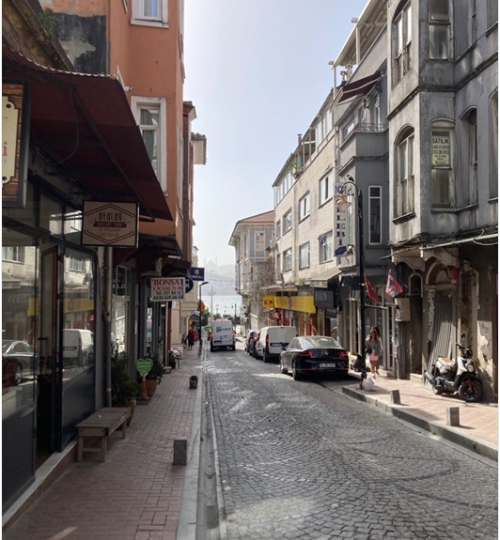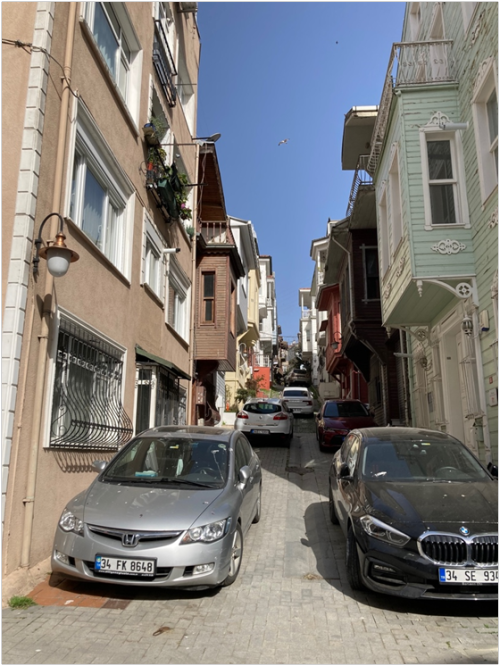
My mother still lives in the same two-bedroom apartment on Tayyareci Suphi Street in Arnavutköy, where I was born and raised, a few minutes’ walk away from the Bosphorus. Though I am now based in the United States, Arnavutköy is still a place I think of as home, full of memories about family, friends, neighbors, buildings, shops, and so on.
Today’s town is quite different from the one I grew up in, though! Even compared to 2006, when I left Istanbul for New York to pursue a PhD degree, the neighborhood has a significantly different appearance and vibe. Obviously, change is a reality of life, but I am not happy about the kind of change that is destroying the place that had a huge impact on my growth as a person, replacing it with something I find rather superficial.
Arnavutköy has recently become one of the most popular neighborhoods in Istanbul. Its cafes, bars, seafood restaurants, art galleries, and, most importantly, its irreplaceable location on the coast of the Bosphorus attract people of all ages every day. It is one of the few towns in the city where the historic fabric is relatively well preserved. While most of them were demolished and rebuilt with steel and concrete, many of the old wooden Ottoman houses¾once homes to Turkish, Greek, Armenian, and Jewish families¾are still standing, resisting the damaging effects of natural and human elements. The multicultural history of the town is also well represented in its religious buildings. The 19th century Tevfikiye Mosque on Akıntıburnu is a good example of Late Ottoman architecture. The Greek Orthodox Church of Great Archangels, also built in the 19th century, continues to function and ring its bells daily, despite its severely contracted community. If you follow Tayyareci Suphi Street, which starts in front of the main doors of this church, you will also find the ruins of a Jewish synagogue three blocks away, waiting for decades to be restored. A lot of people visit Arnavutköy daily to walk through its streets imbued with the ambiance created by these historical structures, telling the story of a long-lost multi-cultural community.

Tayyareci Suphi Street in Arnavutköy, with a view of an old Ottoman house on the right (photo by the author).

Ruins of the Jewish Synagogue of Arnavutköy on Tayyareci Suphi Street (photo by the author).
What has changed in Arnavutköy from the perspective of a local? It was once a town inhabited predominantly by middle and lower-middle class families (if you set aside the rather wealthy dwellers of the apartment buildings and mansions lining the Bosphorus coast). The process of gentrification has visibly altered this situation in the last three decades. Many of the old Ottoman houses, typically owned by low and middle-income families until the 1990s, were sold at high prices to high-income buyers. It was certainly a good deal for those families, because each could buy with that amount of money 2-3 brand new apartments in Istanbul’s newly developing boroughs such as Ümraniye or Avcılar. Some of my childhood friends left the town for that reason. New owners of old Ottoman houses generally preferred to tear down the old structures and rebuild them with modern materials and new interior plans, albeit keeping exterior façades the same or close to the original. Furthermore, many of these “renovated” buildings have not become homes to new families but have been converted into work spaces used by television production companies, architectural firms, and so on. As a result, the center of the town, in particular, has lost some of its warm residential character and become a business location for those companies and recently opened bars, cafes, and restaurants.

A recently renovated house on Beyazgül Avenue (photo by the author).
A corollary of these developments is that there are today fewer and fewer children on the streets of Arnavutköy. As in every other neighborhood of Istanbul, the town’s streets were once children’s playgrounds. From soccer to hide-and-seek, I remember playing all kinds of games with my friends who lived in the apartment building across the street or in the old wooden houses two, three, or four blocks away from my family’s apartment. We often played heated soccer games (so-called mahalle maçları) with the children living on the other side of the town. The shouting of old neighbors, complaining about our noise, was a constant feature of our daily routine. It is impossible today to see such scenes in Arnavutköy. There are various reasons behind this, and one of them is definitely the small-sized companies using the former residential buildings as work spaces. Also, there are many fewer families with children based in the neighborhood today compared, for instance, to thirty years ago. Finally (and I think this is also an important reason), the streets are not safe for children anymore due to high volumes of car traffic. They are not even available for playing, because Arnavutköy’s narrow streets are generally occupied today by the cars belonging to the customers of the seafood restaurants, cafes, and bars lining the town’s main street. The parking attendants hired by these venues (called değnekçi in Turkish) control the streets and do not allow others to park there (I have had a couple of heated exchanges with these guys myself in the past few years!). Many streets of Arnavutköy are blocked by these people for customers’ cars for most of the day. As a result, sometimes walking through a street may turn into a difficult task even for an adult! The few streets that are open are not safe, either, due to the intensified traffic created by the cars driven by değnekçi or by people visiting the town. No sane parent would allow their children to play on these streets; and, without children’s noises on its streets, Arnavutköy feels rather empty to me.

View of Dubaracı Street in Arnavutköy (photo by the author).
Not surprisingly, the new Arnavutköy is also louder, thanks to the car traffic and people visiting the town. In the evenings and throughout the night, the town’s main street where most of the cafes, bars, and restaurants are located is always congested. A new (and very irritating) trend is bar customers having their drinks on pedestrian walkways and streets, thus blocking traffic. Fights among inebriated customers constitute another new scene taking place more and more often (one of them took place a couple of months ago in front my mother’s apartment at 2:00 AM). Nowadays, the inhabitants of Arnavutköy are also used to seeing vomit, broken beer bottles, and other stuff left on their streets by bar customers. Thus, the outcome of being a popular venue of entertainment and social life in Istanbul is not all positive for the neighborhood’s residents.
The current state of Arnavutköy reminds me of what has been lost in the past decades: a calm, multi-cultural Bosphorus town, the inhabitants of which mostly knew and respected each other. At this point, I should note that this change started much earlier than my lifetime. For instance, the apartment building where I lived most of my life was constructed nine years before my birth, replacing two old wooden Ottoman houses. The town’s non-Muslim inhabitants started leaving at an accelerating rate from the 1950s onwards as a result of antagonistic attacks towards Turkey’s religious minorities. And I know that many people who have lived in old neighborhoods of Istanbul (or other cities) from very early on feel the same unease towards the relentless waves of change brought about by modern society. I still want to note that the Arnavutköy of my childhood and youth was a safer and fairer place. That doesn’t mean that I’ve given up on it, though. Arnavutköy is still the only place in the whole city I want to live in. Nothing can replace the pleasure of having tea against the view of the Bosphorus and the Bridge or walking on its streets. Although many of its past people, buildings, shops, and so on are gone, my memories will compensate for that loss. Despite the damages of time, Arnavutköy continues to be beautiful and enchanting.

